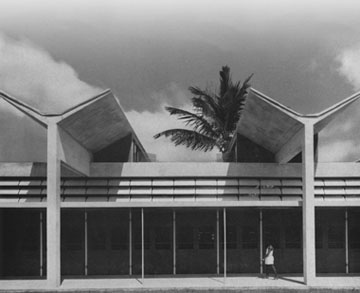|

Ghana: Accra, Kumasi & Cape Coast
African Modernism of the 1960s and 70s
Outside the night is cool, the stars are brilliant, and friends sit talking on the terrace, free and unconfined. They are being systematically
bitten by blood-tainted female anopheles mosquitoes, but what do they care, with gin and paladin to soothe and safeguard them?
(Fry, M., & Drew, J. (1956). Tropical Architecture in the Humid Zone)
During the late 1950s and the early 1960s most of the countries of Central and Subsaharan Africa gained their independence. Architecture became one of the principal means with which the young nations expressed their national identity. Parliament buildings, central banks, stadiums, conference centers, universities and independence memorials were constructed, often featuring heroic and daring designs. Modernistic, and often futuristic architecture mirrored the aspirations and forward looking spirit that was dominate at that time. A coinciding period of economical boom made elaborate construction methods possible while the tropical climate allowed for an architecture that blended the inside and outside, focused on form and the expression of materiality without the need for insulation or heating. The architecture in the capital cities of countries such as Kenya, Ivory Coast, Zambia, Ghana or Cameroon still represents some of the best examples of 60s and 70s architecture. Nevertheless it has received little attention and still remains to be ‘rediscovered’.
To study examples of this oeuvre we will travel for one week to Ghana in Western Africa and visit its capital Accra, as well as the cities of Kumasi and Cape Coast. Previously a British colony, Ghana was the first Subsaharan country to gain its independence (1957) and due to its stability and overall democratic political system, has been described as the poster child of African nations. Our visit will start at the Independence Square in Accra’s center, featuring a bizarre fusion of a triumphal arch meets spectator’s stand, continue to the magnificent former US embassy (today’s Ministry of Women’s and Children’s affair), the heroic International Conference Center as well as several other residential and administrative buildings of the capital. We will travel to Kumasi for a visit to Ghana’s leading faculty of architecture at the Kumasi University of Science and Technology as well as Cape Coast with the beautiful campus of its local university, while taking a short dip in the Atlantic Ocean at one of its endless sandy beaches. Building up on the studio’s theme, the trip will focus on the physical presence of public institutions in the urban environment and the question of how the state represents itself. Join us for a unique opportunity to travel to one of the highlights of global architectural history in a region rarely visited.
Afrikanischer Modernismus der 1960er und 70er
Draussen, die Nacht ist kühl, die Sterne brillant, Freunde sitzen auf der Terrasse und plaudern frei und unbekümmert. Sie werden systematisch von blutrünstigen weiblichen Stechmücken gebissen, aber was kümmert es sie, mit Gin und Paladin als Schutz und Linderung?
(Fry, M., & Drew, J. (1956). Tropical Architecture in the Humid Zone)
Während der späten Fünfziger und frühen Sechziger Jahren wurden die meisten zentral- und schwarzafrikanischen Länder unabhängig. Architektur wurde zu einem der wesentlichen Mittel, mit denen die jungen Staaten ihre nationale Identität zum Ausdruck brachten. Parlamentsgebäude, Es wurden Zentralbanken, Stadien, Konferenzzentren, Universitäten und Unabhängigkeitsdenkmäler gebaut, die meist einem mutigen und heroischen Stil aufwiesen. Die modernistische und futuristisch anmutende Architektur spiegelte den zukunftsweisenden und hoffnungsvollen Geist wieder, der zu jener Zeit vorherrschte. Ökonomische Boomjahre erlaubten aufwendige Bauweisen während das tropische Klima eine Architektur ermöglichte die Innen und Aussen verschmelzen liess, und die Ausdrucksstärke von Materialität und Form in den Vordergrund stellte. Die Architektur der Hauptstädte von Ländern wie Kenia, Elfenbeinküste, Sambia, Ghana oder Kamerun repräsentiert einige der besten Beispiele der Architektur der 60er und 70er Jahre. Nichtsdestotrotz hat sie bislang wenig Aufmerksamkeit erhalten und erwartet noch ihre ‹Wiederentdeckung›.
Um Beispiele dieses Werks zu studieren und zu dokumentieren reisen wir für eine Woche nach Ghana in Westafrika, wo wir die Hauptstadt Accra sowie die Städte Kumasi und Cape Coast besuchen werden. Ehemals eine britische Kolonie war Ghana das erste Land südlich der Sahara, dass seine Unabhängigkeit erhielt. Auf Grund seiner Stabilität und seines demokratischen Systems ist es als Musterkind Afrikas beschrieben worden. Unser Besuch beginnt auf dem ‹Independence Square› in Accras Zentrum, mit seiner bizarren Mischung aus Triumphbogen und Stadiumtribüne. Danach besichtigen wir die grossartige ehemalige amerikanische Botschaft (heutiges Familienministerium), das heroische internationale Konferenzzentrum sowie mehrere weitere Wohn- und Administrationsbauten. Wir reisen nach Kumasi um Ghanas führende Architekturfakultät an der Kumasi University of Science and Technology zu besuchen, sowie nach Cape Coast mit ihrem eigenen wunderbaren Universitätscampus, sowie einem kurzen Sprung in den Atlantik an einem der endlosen Sandstrände. Auf das Thema der Dozentur aufbauend, wird die Reise das Augenmerk auf die physische Präsenz von öffentlichen Institutionen im städtischen Raum richten, sowie auf die Frage der Repräsentation einer Nation mittels Architektur. Die Seminarreise ist eine einzigartige Gelegenheit eines der Glanzpunkte der jüngeren Architekturgeschichte in einer selten besuchten Region kennenzulernen.
Reisedaten: 19 - 28 Oktober
Kostengruppe: F (ca. 1’800 CHF)
Bei Fragen: hansfo@arch.ethz.ch
Download: PDF
20.08.2012 webmaster@arch
|
|


